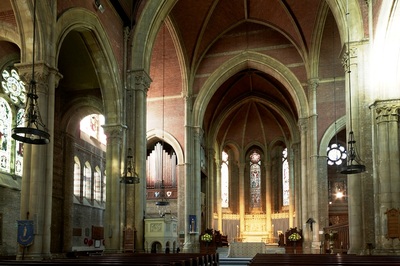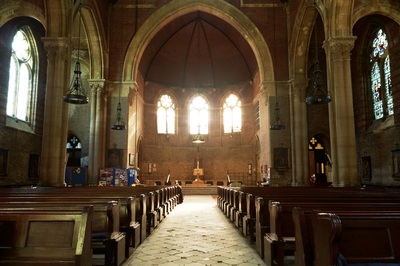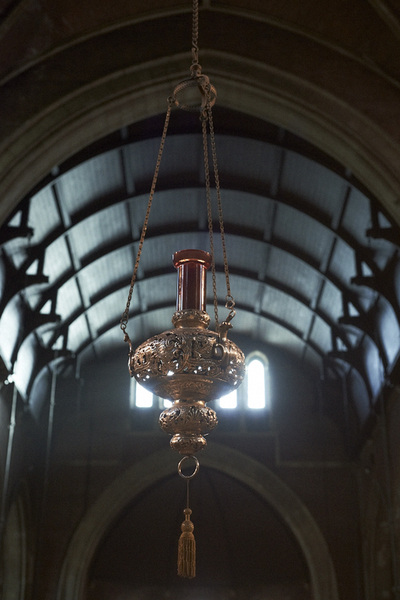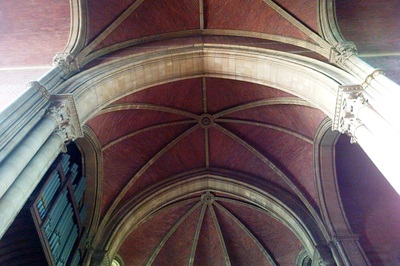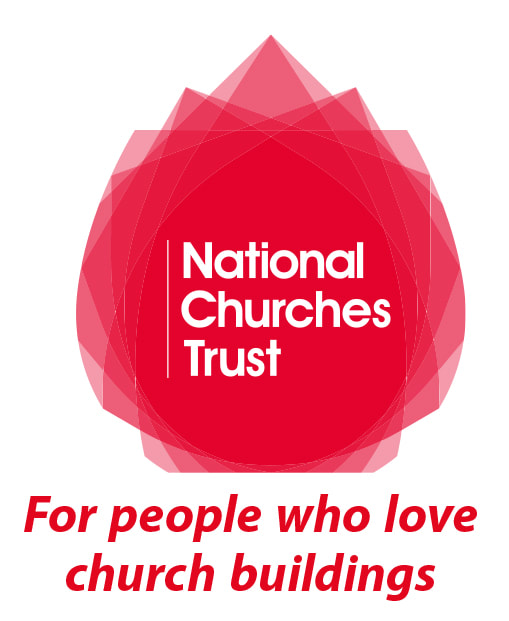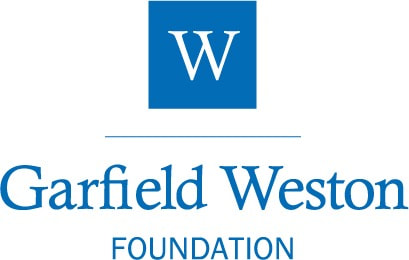Church History
|
St Mary's Chapel, built in 1825-6, with the Earl of Egremont's East Lodge behind.
|
The first St Mary's
The St Mary's Church that we know today is the second church to stand on the spot. The first St Mary's was a private chapel, built in 1825-6, that became famous for its association with the Evangelical divine, Henry Venn Elliott. In 1824 property speculator Barnard Gregory (1796–1852) secured a private act of parliament for building a chapel in the eastern part of Brighton. The Earl of Egremont provided a plot in the grounds of East Lodge, Upper Rock Gardens, and local architect Amon Henry Wilds (c.1790–1857) produced a Greek Revival design, modelled on the ruined Temple of Nemesis at Rhamnus. The construction was beset by problems, however, and in 1826 Gregory sold the incomplete chapel to Charles Elliott (1751–1832), a royal cabinetmaker who had recently retired from Clapham to Hove. |
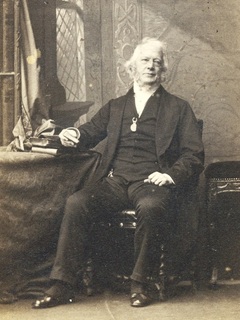 The Revd Henry Venn Elliott (1792-1865)
The Revd Henry Venn Elliott (1792-1865)
The Revd Henry Venn Elliott
Charles Elliott was a member of the Clapham Sect and friend of the great anti-slavery campaigner, William Wilberforce. His second wife, Eling, was the daughter of the Revd John Venn, one of the founders of the Church Missionary Society.
In 1827 Charles installed his son, the Revd Henry Venn Elliott (1792–1865), as the first perpetual curate of St Mary’s Chapel. Under Henry’s leadership, St Mary’s became one of the most fashionable chapels in Brighton, and drew preachers and churchgoers from around Britain and the Empire.
He himself became a nationally significant Evangelical divine and in the course of his work founded St Mary’s Hall, a school for the daughters of poor clergymen, and its associated church, St Mark’s. He was also one of four founder-directors of Brighton College.
Henry’s sister, Charlotte Elliott (1789–1871), was a poet and prolific composer of hymns, including the internationally famous Just as I Am (1835), the royalties from which helped fund St Mary’s Hall. She also edited the Religious Remembrancer.
Charles Elliott was a member of the Clapham Sect and friend of the great anti-slavery campaigner, William Wilberforce. His second wife, Eling, was the daughter of the Revd John Venn, one of the founders of the Church Missionary Society.
In 1827 Charles installed his son, the Revd Henry Venn Elliott (1792–1865), as the first perpetual curate of St Mary’s Chapel. Under Henry’s leadership, St Mary’s became one of the most fashionable chapels in Brighton, and drew preachers and churchgoers from around Britain and the Empire.
He himself became a nationally significant Evangelical divine and in the course of his work founded St Mary’s Hall, a school for the daughters of poor clergymen, and its associated church, St Mark’s. He was also one of four founder-directors of Brighton College.
Henry’s sister, Charlotte Elliott (1789–1871), was a poet and prolific composer of hymns, including the internationally famous Just as I Am (1835), the royalties from which helped fund St Mary’s Hall. She also edited the Religious Remembrancer.
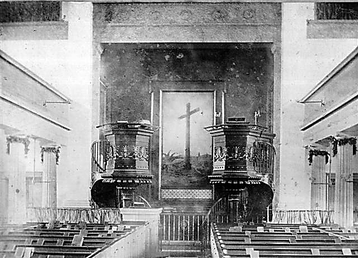 The interior of old St Mary's Chapel, c.1860.
The interior of old St Mary's Chapel, c.1860.
The fall of St Mary's Chapel
After Henry’s death in 1865, his younger surviving son, the Revd Julius Marshall Elliott (1841–1869), inherited the chapel. A talented mountaineer, he was killed in a fall from the summit of Mount Schreckhorn in the Swiss Alps in 1869. The font in St Mary’s Church is dedicated to his memory and provides an important link between the old chapel and the new church.
The chapel’s ownership thereupon passed to Henry’s other surviving son, Charles Alfred Elliott (1835–1911), a member of the Indian Civil Service and future Lieutenant-Governor of Bengal. As the original act of parliament had granted proprietorship of the chapel for 40 years only, he began negotiations to transfer the chapel to the Ecclesiastical Commissioners. He and his sisters also gave funds to help convert it into a parish church, with a clearly defined chancel and sanctuary, something the existing building lacked.
Building work was underway when, in June 1876, the north end of the chapel collapsed revealing the shoddiness of the original construction. The Elliotts then contributed more money (close to £7,000 in all) towards the construction of the new St Mary’s Church, the cornerstone of which was laid by Charles’s sister Blanche on 29 May 1877.
After Henry’s death in 1865, his younger surviving son, the Revd Julius Marshall Elliott (1841–1869), inherited the chapel. A talented mountaineer, he was killed in a fall from the summit of Mount Schreckhorn in the Swiss Alps in 1869. The font in St Mary’s Church is dedicated to his memory and provides an important link between the old chapel and the new church.
The chapel’s ownership thereupon passed to Henry’s other surviving son, Charles Alfred Elliott (1835–1911), a member of the Indian Civil Service and future Lieutenant-Governor of Bengal. As the original act of parliament had granted proprietorship of the chapel for 40 years only, he began negotiations to transfer the chapel to the Ecclesiastical Commissioners. He and his sisters also gave funds to help convert it into a parish church, with a clearly defined chancel and sanctuary, something the existing building lacked.
Building work was underway when, in June 1876, the north end of the chapel collapsed revealing the shoddiness of the original construction. The Elliotts then contributed more money (close to £7,000 in all) towards the construction of the new St Mary’s Church, the cornerstone of which was laid by Charles’s sister Blanche on 29 May 1877.
|
Architect William Emerson
Charles Elliott's work as an Indian Civil Servant had introduced him to William Emerson, a young English architect who had been commissioned to design Muir College and All Saints' Cathedral in the north Indian city of Allahabad. Elliott first appointed Emerson to enlarge the original St Mary's Chapel and then, when it collapsed, asked him to stay on and design a new church. William Emerson (1843-1924) first went to India in 1866. He had trained with the great Gothic Revivalist, Sir William Burges, and his early buildings in Bombay were exemplars of Muscular Gothic, a heavy, massive style inspired by the 13th-century French tradition which had enthralled Burges. But in 1869 Emerson visited the Taj Mahal and experienced an architectural epiphany. This marvellous marble tomb to a Muslim queen was, he wrote, ‘a more beautiful place than I ever dreamed of’. Henceforth he began to experiment with combining what he saw as the best features of the world’s grand architectural traditions, and in Britain he called repeatedly for a loosening of Gothic Revivalism’s hold on church architecture. |
Some of William Emerson's buildings in India.
|
Knighted in 1902, Emerson is best remembered for designing the Victoria Memorial in Calcutta and for his term as President of the Royal Institute of British Architects (1899–1902). St Mary’s is his only surviving church in Britain and also his only building to be listed Grade II*.
|
|
The new St Mary's Church
The new St Mary's Church was consecrated on 14 October 1878. Emerson used a broadly Gothic style, but with significant Oriental and Classical features reflecting his love of architectural hybridity. By this stage he had come to regard the Victorian fashion for recreating the mediaeval church as unsuited to the needs of large, urban congregations. His design for St Mary’s was a consciously modern, forward-looking one, with seating for some 900 people with minimal impediments to sight-lines and no chancel screen. The arches of the nave arcade are high and broad, the compound piers are designed to look slender, and the nave itself is exceptionally wide and the crossing unusually deep. The result has none of the heaviness of the early Gothic style in which Emerson had been schooled. He built an open, welcoming space that sat happily with the Evangelicalism of the Elliott family and which still works remarkably well today. |
Commentators have often tried to pigeonhole the style of St Mary's as ‘13th-century French Gothic’ or ‘Early English Gothic’ and found it wanting in purity. But that is to mistake the architect's intentions. In 1884, six years after he completed St Mary's, he explained his approach, calling for an architectural renaissance whose arms shall be long enough and bold enough to embrace the lintel, the round arch and the pointed arch, the picturesqueness of the Gothic vault, and the dignified nobility of the Classic and Oriental dome; where the crudities of Gothic art shall be eliminated and the refinements of Classic art introduced.
|
Building features
St Mary’s exists today largely as it was built, with no external additions and relatively few intrusive ones in the interior. It almost completely fills its site, reflecting Emerson's attempt to maximize the sittings in the building (900 at consecration). The site also dictates the church's unusual north-south orientation; the chancel points north and what would normally be called the 'West Front' actually looks south to the sea. The church is built on a cruciform plan, though the openness of Emerson's design rather disguises this. A curved baptistery at the south end gives a Byzantine or Romanesque feel to the whole. The principal building materials are a local red brick, which is laid in English bond, with exterior dressings and trims in pinkish Corsehill sandstone from Dumfriesshire and Bath limestone. The interior is of red and buff bricks, with Bath stone piers and dressings. The nave has a handsome barrel vault roof in dark stained pine, with small oak hammer beams terminating in carved lion's-head finials. The crossing and chancel have exceptionally fine vaulting in red brick. |

